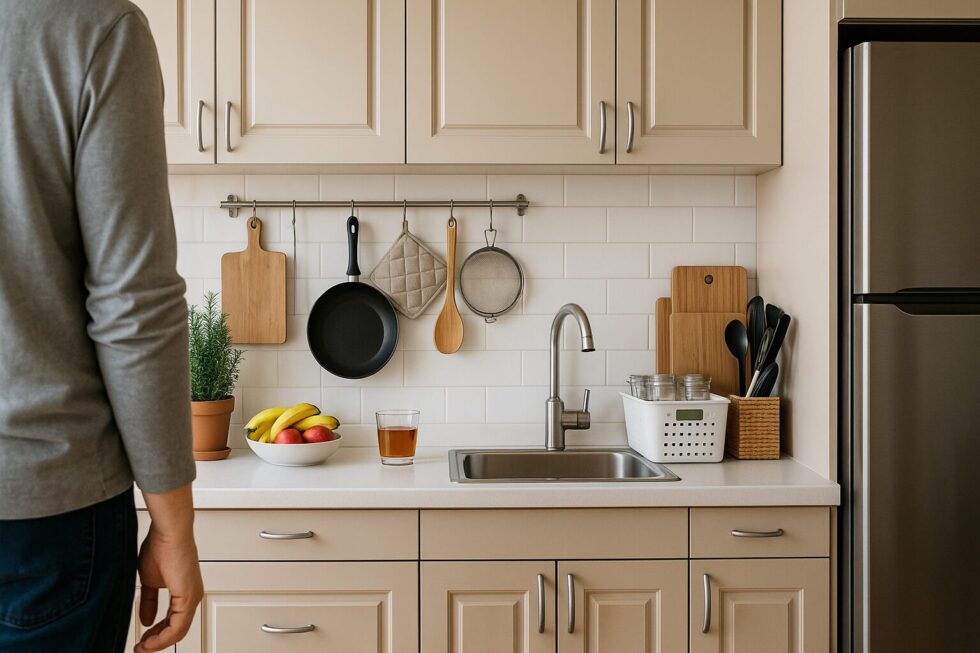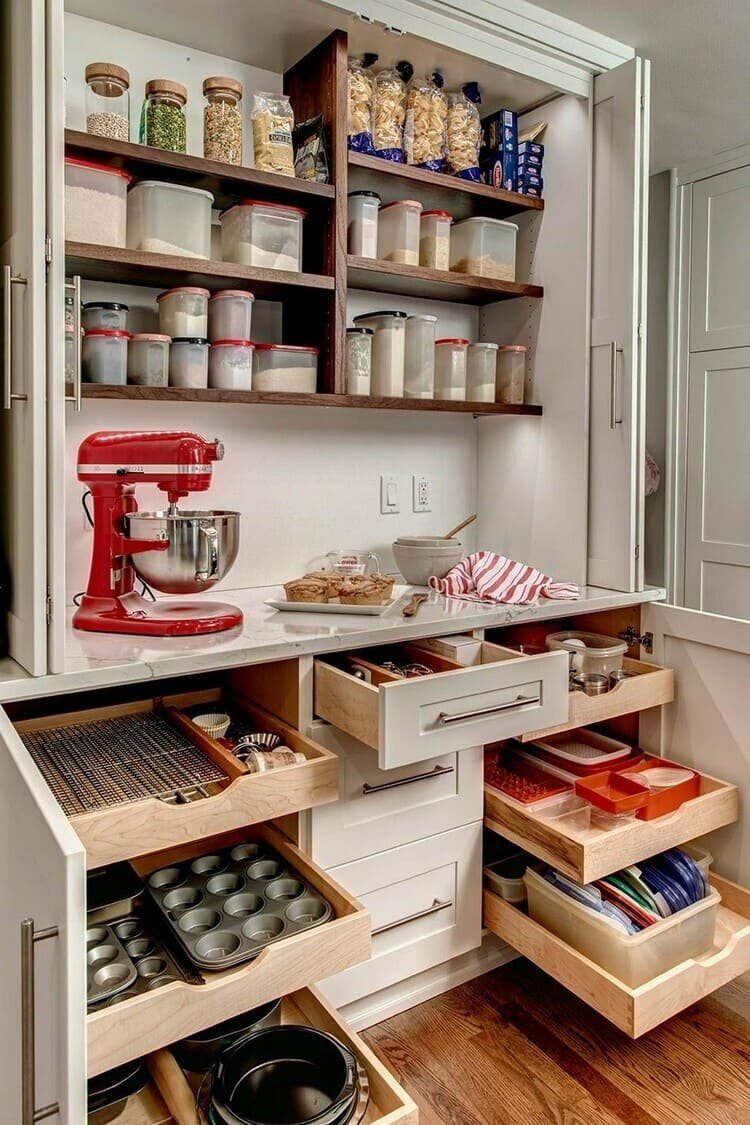How to make your kitchen more convenient without renovation: practical tips for organizing space

The kitchen is the heart of the home, a place not only for cooking but also for family gatherings and conversations. Yet, even in spacious apartments, the kitchen can feel cramped and uncomfortable if storage is poorly organized. People often assume that to improve functionality they need a full renovation, but in reality, small and affordable accessories can make a huge difference. By adding smart organizers, wall-mounted hooks, folding tables, and modular containers, you can free up space, speed up meal preparation, and create a more pleasant atmosphere. These solutions don’t require professional installation or large budgets and can be implemented in just a few hours. The trend of optimizing kitchens with compact accessories is especially popular in German cities, as noted by G.business.
Mini organizers: small solutions for big space savings
Organizers are among the simplest yet most effective tools for improving kitchen ergonomics. Instead of letting utensils and small items pile up randomly, dividers and boxes create clear sections. This reduces the time spent looking for items and minimizes clutter. For families with children, organizers are especially useful because they help everyone in the household know exactly where things belong. They come in a variety of materials — from inexpensive plastic to elegant bamboo — and fit into drawers, shelves, or even refrigerators. Using modular systems, you can expand or rearrange them as needed, making them a long-term solution. In fact, surveys show that people who use organizers save up to 20 minutes per day during cooking simply because everything is in the right place.
Examples of useful organizers:
- cutlery trays with adjustable dividers;
- rotating trays (Lazy Susan) for condiments and oils;
- stackable boxes for snacks and tea bags;
- vertical racks for lids, cutting boards, and trays;
- slim baskets for fridge shelves to prevent wasted space.
Wall hooks and rails: keeping everything in sight
Vertical space is often overlooked in kitchens, but it can be transformed into one of the most functional areas. Rails and hooks allow you to hang tools and utensils that would otherwise take up valuable drawer space. By creating a "working wall," you keep frequently used items within arm’s reach, making cooking faster and smoother. Rails can be installed above the stove, next to the sink, or along a free wall. Modern models often don’t require drilling, making them perfect for renters who don’t want to damage walls. A rail system not only organizes the kitchen but also adds a stylish, professional look, reminiscent of restaurant kitchens. With prices starting from just €10, this is one of the most cost-effective upgrades available.
Items that can be stored on rails and hooks:
- mugs and cups (to save cupboard space);
- towels, aprons, and oven mitts;
- large utensils such as ladles and spatulas;
- hanging baskets filled with spices or herbs;
- lightweight pots and pans for daily use.
Folding tables and pull-out surfaces: solutions for small kitchens
In many German apartments, kitchens are compact, and the lack of counter space becomes a constant challenge. Folding tables and pull-out surfaces solve this problem without requiring a complete redesign. A folding table mounted on the wall can serve as a dining spot or an additional prep area and folds away when not needed. Pull-out shelves inside cabinets create temporary work surfaces for chopping vegetables or holding appliances. These solutions are especially useful for single-person households or couples living in smaller spaces, where every bit of functionality counts. Moreover, folding furniture can be stylish, available in wood, steel, or minimalist white finishes that blend with modern interiors. With an average cost of €60–120, they offer great value compared to the expense of a kitchen remodel.
Popular options include:
- compact wall-mounted fold-out tables for breakfast corners;
- pull-out chopping boards integrated into cabinets;
- foldable corner tables for unused corners;
- retractable worktops hidden under countertops.
Smart food and dish storage
One of the biggest sources of frustration in kitchens is food waste and clutter caused by poor storage. Transparent containers solve this by letting you see exactly what you have, while also keeping food fresh for longer. Using labeled jars for spices and staples ensures that ingredients are always within reach and easy to identify. Stackable shelves for plates and cups maximize vertical space in cabinets and make it easier to set and clear the table. For busy families, vacuum containers for leftovers prevent spoilage and save money on groceries. Investing €20–40 in a set of modular containers often pays for itself in just a few months. Organized storage also makes kitchens feel cleaner and more visually appealing, creating a space where cooking becomes enjoyable rather than stressful.
Best practices for efficient storage:
- transparent glass jars with labels for spices and grains;
- vacuum-sealed containers for cooked food;
- modular fridge bins to separate dairy, vegetables, and snacks;
- multi-level racks for dishes and bowls;
- vertical slots for chopping boards and trays.
How to use doors and corners for storage
Cabinet doors and corner spaces are often neglected, yet they offer tremendous potential for extra storage. Installing hanging organizers on cabinet doors transforms unused surfaces into valuable storage areas for cleaning supplies or baking sheets. In corner cabinets, rotating carousels allow easy access to items that would otherwise be hidden in the back. This not only saves space but also prevents items from being forgotten and expiring. Foldable corner tables can create additional seating or counter space in kitchens where space is at a premium. With the right approach, you can increase usable space in your kitchen by up to 15% without expanding the room itself. This makes door and corner solutions particularly useful in apartments where storage space is limited.

Practical ideas for doors and corners:
- over-the-door baskets for cleaning products;
- racks for lids and baking trays;
- corner carousel shelves inside cabinets;
- foldable corner tables for multi-purpose use;
- door-mounted spice or snack racks.
Price overview of popular solutions
For households planning a kitchen upgrade, knowing the cost of accessories in advance is useful. In Germany, most items are available both in physical stores and online, with price ranges depending on material and brand. Many shops also offer discounted sets of containers or organizers, making it affordable to reorganize your kitchen in one go.
| Solution | Average price | Where to buy |
|---|---|---|
| Drawer dividers | €5–15 | IKEA, Amazon |
| Lazy Susan rotating tray | €10–25 | Otto, Mömax |
| Wall rail with hooks | €20–40 | Obi, Bauhaus |
| Hanging baskets | €15–30 | Lidl, Höffner |
| Wall-mounted folding table | €60–120 | IKEA, Wayfair |
| Set of food containers | €20–40 | Tchibo, Amazon |
Useful stores and online platforms in Germany
German retailers and e-commerce sites offer a wide variety of kitchen organization tools. Whether you prefer browsing in person or shopping online, you can find affordable and durable options. Always check seasonal promotions, as many shops offer discounts of up to 30% on kitchen accessories.
Where to shop:
- IKEA Deutschland – www.ikea.com/de — a large selection of organizers, folding tables, and modular containers.
- Amazon.de – www.amazon.de — wide assortment with fast delivery options.
- Otto.de – www.otto.de — stylish kitchen organizers and shelving solutions.
- Mömax.de – www.moemax.de — affordable storage baskets and rails.
- Bauhaus.info – www.bauhaus.info — durable hooks, rails, and wall storage systems.
- Tchibo.de – www.tchibo.de — container sets and space-saving storage kits.
- Wayfair.de – www.wayfair.de — folding tables and compact multifunctional furniture.
Transforming your kitchen into a practical and pleasant space doesn’t require expensive renovations. With smart accessories such as organizers, rails, folding tables, and transparent containers, you can maximize space and comfort with minimal investment. The key is to approach the process systematically: assign clear storage zones, make use of vertical areas, and choose modular solutions that can grow with your needs. Even a few adjustments can save time during cooking, reduce food waste, and make the kitchen a centerpiece of the home once again. For both small apartments and larger houses, these ideas bring structure and elegance without construction work.
Stay connected for news that works — timely, factual, and free from opinion — and insights that matter now: How to choose high-quality curtains that will last for years